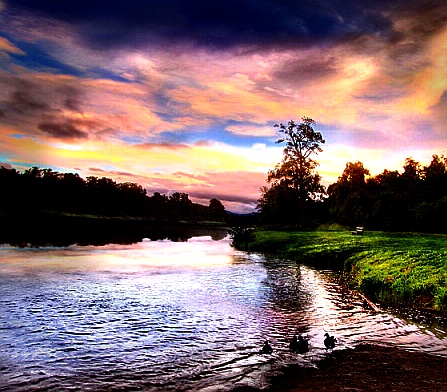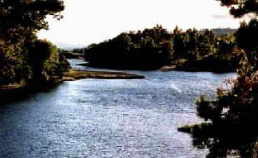The River Spey
(Fishing & Forestry Home
of Moray "Speyside" Geddie's)


Magnum
et miserabile flumen, quod vocatur Spe
("the large and
dangerous river, which is called Spey")
- from a 12th
century manuscript De Situ Albaniae
The River Spey's name is
Celtic, probably meaning hawthorn stream but possibly
describing its frothing swiftness. It’s a river that
conjures many other pictures too - of salmon, whisky,
birds or otters; of walking, canoeing or pinewoods: or
simply ever-changing waters. The Spey offers all these
pleasures and more. It’s a river to savour, remember
and respect.
The Spey is the second longest
river in Scotland and owes much of its character to two
major events. More than 400 million years ago, the
granite rocks of the Grampian Mountains were formed.
Rain, sun, wind, rivers and ice eroded many peaks to
leave the rounded shapes of the Monadhliath and Cairngorm
ranges. During the past 2.5 million years, huge glaciers
tore away much of the rock to create the great strath
(Gaelic for broad valley) of the Spey. The loose rocks
and the spreads of sands and gravels are the debris left
by the great ice flows and their melt waters. As the
river approaches the sea, it runs over sandstone, often
altering its channels before meeting the shifting shingle
ridges of the coast.
Overall, the Spey is one of the
most unpolluted rivers in Britain and its status as a
protected area will help to maintain water quality. Both
river and riverside provide habitats for many plants,
insects, birds and mammals. Most species are dependent
upon the river and often upon each other. Otters eat fish
that need well-aerated waters and live among bankside
plants that are home to insects and other invertebrates.
Birds eat insects and larvae, fish and small creatures,
fruit and pine kernels, according to their species. Any
interruption of this precious ‘web of life’ can
have long-term consequences, often for more than one
species. The waters and wildlife of the Spey, set against
the mountains, attract many people. Visitors bring added
vitality and much-needed business to the community -
adding to the river’s web of life. The Spey is an
area worthy of special conservation for many reasons.
The Atlantic salmon holds a
special place in most people’s affections, whether
for its indomitable energy, its navigational skills or
simply its taste! Although declining in number elsewhere
in Europe, thousands of mature fish return to the Spey
each year to spawn after time spent at sea. The Spey
supports one of Scotland’s most important salmon
fisheries and attracts anglers from all over the world
prepared to try their luck along beats (stretches)
of the river. The water’s fast and relatively even
flow, and its lack of pollution and obstructions, mean
salmon can spawn throughout most of its length as well as
in many tributaries. Eggs laid in shallow redds
produce fry which grown into parr and then smolts.
Freshwater pearl mussels are
endangered across Europe as a result of over-fishing,
pollution and poor management of rivers and catchments.
The Spey is one of the few rivers where they continue to
thrive - helped by Operation Necklace which
highlighted their protection under the law. Many mussels
have also been saved from persecution in the deeper,
inaccessible waters of the river. The soft, clean waters
of the Spey provide ideal conditions. Females produce up
to a million eggs which, once fertilised, are squired out
as larvae called glochidia. They survive only if
they are inhaled by young salmon and trout and attach
themselves to the gills. The fish’s skin forms a
cyst over each one which then harmlessly feeds off its
host until it drops off the next spring. Only a few
survive to burrow into the riverbed’s sand or gravel
where stones provide some shelter.
Every otter needs its own
territory, which it marks with spraints
(droppings) and which takes in a large area of
little-disturbed waterside with plenty of undergrowth.
Adults mate here, often after extended play. They use
grass and moss to line a den or holt where females later
give birth. Mothers rear the young, teaching them to swim
and fish, often pushing the cubs into the water to get
them started! In many other parts of Europe, otters have
suffered from destruction of their habitat. However,
otters are widespread along the Spey, making it one of
the best freshwater sites in Scotland for these agile
swimmers. The catchment provides water of high quality
and abundant food in its many lochans, ponds and marshy
patches. Otters eat all kinds of fish but prefer those
with plentiful flat, such as salmon, trout and eel; they
also enjoy frogs and toads.
Maturing sea lampreys live off
fish such as haddock, code, salmon and trout, using their
teeth to scrape a hole in their prey before drawing out
blood. They then forsake feeding when they leave the
Moray Firth to spawn in the clean gravel of the
Spey’s middle and lower reaches. During mating, the
male grips the larger female with the mouth and
fertilises the 200,000 eggs she lays. Larvae hatch after
three weeks and follow the current downstream before
burrowing into the riverbed’s silt and sand. Up to
five years later, after feeding on tiny organisms, they
emerge and transform quickly into eel-like adults. They
can grow to 50cm (20in) in length but have no bones -
their skeletons are made entirely of cartilage. Sea
lampreys have declined in parts of Europe but the Spey
provides the right habitat conditions for all stages of
their development. The river’s population is the
most northerly in Britain’s freshwaters and one of
Scotland’s best sites for the species.

In 1539, the first recorded
consignment of timber from Strathspey was floated down
the river to Speymouth. Over the next 350 years or so,
large areas of Caledonian pine forest were felled to
build ships and houses. Much went south by sea but
Garmouth and Kingston later became shipbuilding ports in
their own right. Increasing road transport demanded that
the Spey be bridged and Telford’s arch at
Craigellachie is the most graceful of any structure. It
still stands, having escaped damage in the Muckle
Spate of 1829 that devastated much of Strathspey and
Speyside including many of the other bridges. Flooding
remains a problem today when flash storms turn the river
and its tributaries into torrents. Because the river has
always attracted salmon and trout, commercial fishing has
been practised for at least 500 years, using various
netting methods. Netting in the river itself and its
coastal area extended in the early 1990s.
Like many other great rivers,
the Spey and its tributaries play their part in the local
economy. Two hydro-electric schemes draw water from the
upper catchment and downstream, near Fochabers, a new
abstraction scheme is providing drinking water. But
better known is the catchment’s provision of water
for uisge beatha with around 30 malt whisky
distilleries each producing its distinctive
‘dram’. Nature conservation and outdoor
recreation are increasingly valuable means of generating
income from naturalists, photographers, painters,
anglers, water sports enthusiasts and walkers.
Birdwatchers come particularly to see several species
more usually found in Scandinavia - for example, nearly
all Britain’s breeding goldeneye ducks are found
along the river.
The Spey and its tributaries
are home to four species - the Atlantic salmon, otter,
freshwater pearl mussel and sea lamprey - that are rare,
threatened or endangered in Europe. The river therefore
qualifies as both a Site of Special Scientific Interest
(SSSI) and as a Special Area of Conservation (SAC); the
waters of the catchment form an aquatic environment of
the highest quality. SNH is committed to safeguarding the
wildlife and natural beauty of the river in partnership
with all those who live and work beside it, and visitors
who come to enjoy it. That way, the outstanding qualities
of the Spey and the lands alongside it can continue to be
handed on, with confidence, to future generations.
A map of the Spey deceives as
it informs, for it can’t show the subtleties of the
river’s flow, the light and shade of its landscape
or the complex ‘web of life’ that links water,
plants and animals. The map does show a river, 157 km (98
miles) long, surging from the high moorland of the
Monadhliath (Grey Mountains) and meandering through the
lands of Badenoch, Strathespey and Speyside before
rushing into the Moray Firth.

Return
to Geddie Photo Album
GeddieWorld
Home
|